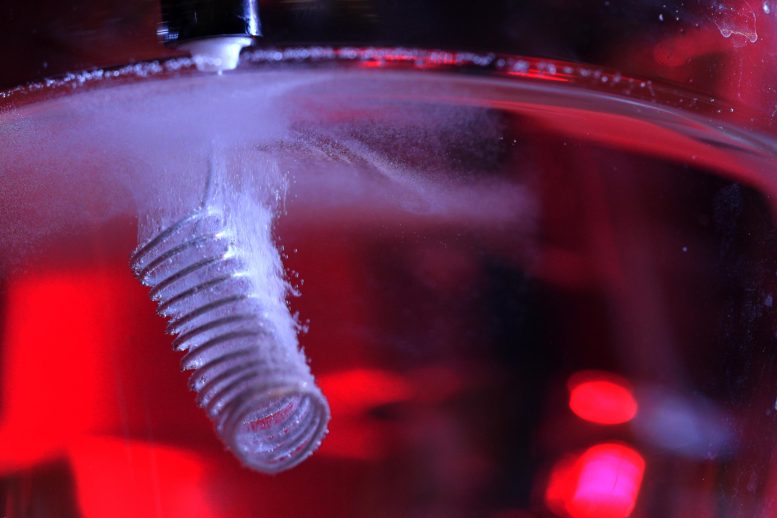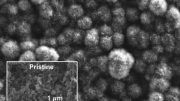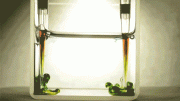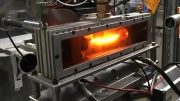
Researchers uncovered how carbon dioxide can be both captured and converted through a single electrochemical process in which an electrode, like the one pictured covered in bubbles, is used to attract carbon dioxide released from a sorbent and convert it into carbon neutral products. Credit: John Freidah/MIT MechE
The findings, based on a single electrochemical process, could help cut emissions from the hardest-to-decarbonize industries, such as steel and cement.
In efforts to curb global greenhouse gas emissions around the world, scientists at MIT are focusing on carbon-capture technologies to decarbonize the most challenging industrial emitters.
Industries such as steel, cement, and chemical manufacturing are particularly hard to decarbonize because of the inherent use of carbon and fossil fuels in their processes. If technologies can be developed to capture carbon emissions and repurpose them within the production process, it may lead to a significant reduction in emissions from these “hard-to-abate” sectors.
However, the current experimental technologies that capture and convert carbon dioxide do so as two separate processes, that themselves require a huge amount of energy to run. The MIT team is looking to combine the two processes into one integrated and far more energy-efficient system that could potentially run on renewable energy to both capture and convert carbon dioxide from concentrated, industrial sources.
Recent Findings on Carbon Capture and Conversion
In a study published on September 5 in the journal ACS Catalysis, the researchers reveal the hidden functioning of how carbon dioxide can be both captured and converted through a single electrochemical process. The process involves using an electrode to attract carbon dioxide released from a sorbent, and to convert it into a reduced, reusable form.
Others have reported similar demonstrations, but the mechanisms driving the electrochemical reaction have remained unclear. The MIT team carried out extensive experiments to determine that driver, and found that, in the end, it came down to the partial pressure of carbon dioxide. In other words, the more pure carbon dioxide that makes contact with the electrode, the more efficiently the electrode can capture and convert the molecule.
Knowledge of this main driver, or “active species,” can help scientists tune and optimize similar electrochemical systems to efficiently capture and convert carbon dioxide in an integrated process.
The study’s results imply that, while these electrochemical systems would probably not work for very dilute environments (for instance, to capture and convert carbon emissions directly from the air), they would be well-suited to the highly concentrated emissions generated by industrial processes, particularly those that have no obvious renewable alternative.
“We can and should switch to renewables for electricity production. But deeply decarbonizing industries like cement or steel production is challenging and will take a longer time,” says study author Betar Gallant, the Class of 1922 Career Development Associate Professor at MIT. “Even if we get rid of all our power plants, we need some solutions to deal with the emissions from other industries in the shorter term, before we can fully decarbonize them. That’s where we see a sweet spot, where something like this system could fit.”
The study’s MIT co-authors are lead author and postdoc Graham Leverick and graduate student Elizabeth Bernhardt, along with Aisyah Illyani Ismail, Jun Hui Law, Arif Arifutzzaman, and Mohamed Kheireddine Aroua of Sunway University in Malaysia.
Understanding the Carbon-Capture Process
Carbon-capture technologies are designed to capture emissions, or “flue gas,” from the smokestacks of power plants and manufacturing facilities. This is done primarily using large retrofits to funnel emissions into chambers filled with a “capture” solution — a mix of amines, or ammonia-based compounds, that chemically bind with carbon dioxide, producing a stable form that can be separated out from the rest of the flue gas.
High temperatures are then applied, typically in the form of fossil-fuel-generated steam, to release the captured carbon dioxide from its amine bond. In its pure form, the gas can then be pumped into storage tanks or underground, mineralized, or further converted into chemicals or fuels.
“Carbon capture is a mature technology, in that the chemistry has been known for about 100 years, but it requires really large installations, and is quite expensive and energy-intensive to run,” Gallant notes. “What we want are technologies that are more modular and flexible and can be adapted to more diverse sources of carbon dioxide. Electrochemical systems can help to address that.”
Her group at MIT is developing an electrochemical system that both recovers the captured carbon dioxide and converts it into a reduced, usable product. Such an integrated system, rather than a decoupled one, she says, could be entirely powered with renewable electricity rather than fossil-fuel-derived steam.
Their concept centers on an electrode that would fit into existing chambers of carbon-capture solutions. When a voltage is applied to the electrode, electrons flow onto the reactive form of carbon dioxide and convert it to a product using protons supplied from water. This makes the sorbent available to bind more carbon dioxide, rather than using steam to do the same.
Gallant previously demonstrated this electrochemical process could work to capture and convert carbon dioxide into a solid carbonate form.
“We showed that this electrochemical process was feasible in very early concepts,” she says. “Since then, there have been other studies focused on using this process to attempt to produce useful chemicals and fuels. But there’s been inconsistent explanations of how these reactions work, under the hood.”
The Role of ‘Solo CO2’
In the new study, the MIT team took a magnifying glass under the hood to tease out the specific reactions driving the electrochemical process. In the lab, they generated amine solutions that resemble the industrial capture solutions used to extract carbon dioxide from flue gas. They methodically altered various properties of each solution, such as the pH, concentration, and type of amine, then ran each solution past an electrode made from silver — a metal that is widely used in electrolysis studies and known to efficiently convert carbon dioxide to carbon monoxide. They then measured the concentration of carbon monoxide that was converted at the end of the reaction, and compared this number against that of every other solution they tested, to see which parameter had the most influence on how much carbon monoxide was produced.
In the end, they found that what mattered most was not the type of amine used to initially capture carbon dioxide, as many have suspected. Instead, it was the concentration of solo, free-floating carbon dioxide molecules, which avoided bonding with amines but were nevertheless present in the solution. This “solo-CO2” determined the concentration of carbon monoxide that was ultimately produced.
“We found that it’s easier to react this ‘solo’ CO2, as compared to CO2 that has been captured by the amine,” Leverick offers. “This tells future researchers that this process could be feasible for industrial streams, where high concentrations of carbon dioxide could efficiently be captured and converted into useful chemicals and fuels.”
“This is not a removal technology, and it’s important to state that,” Gallant stresses. “The value that it does bring is that it allows us to recycle carbon dioxide some number of times while sustaining existing industrial processes, for fewer associated emissions. Ultimately, my dream is that electrochemical systems can be used to facilitate mineralization, and permanent storage of CO2 — a true removal technology. That’s a longer-term vision. And a lot of the science we’re starting to understand is a first step toward designing those processes.”
Reference: “Uncovering the Active Species in Amine-Mediated CO2 Reduction to CO on Ag” by Graham Leverick, Elizabeth M. Bernhardt, Aisyah Ilyani Ismail, Jun Hui Law, A. Arifutzzaman, Mohamed Kheireddine Aroua, and Betar M. Gallant*, 5 September 2023, ACS Catalysis.
DOI: 10.1021/acscatal.3c02500
This research is supported by Sunway University in Malaysia.









I am powerful Green House Gases direct catching plant
fabricater from Myanmar.My plant is chemical neutrali-
zing plant and it can neutralize mainly CO2,CH4,N2O
& SO2 gases from the atmosp-
here. MY plant can catch &
neutralize (864 million M3/day)
from the atmosphere.The plant
can catch (CO2 gas) by weight
( 261,856.02 metric tonne/year)
I am very eager to reduce
global warming and to protect
our people from environmental
catastrophic disasters.
Do NOT remove the plant food from the air, it is NOT a pollutant.
This needs the efficiency rate in the article to be interesting. The word Efficient is the key word in the headline. If you’re burning more coal to power an electrode to capture carbon from coal you previously burnt, it had better be extremely efficient. The article suggests it should be renewables powering this process, so I expect it’s so inefficient as to be better off not doing it at all. Oh, and try and make a renewable energy capturing device without emitting carbon. I do like good news, and more efficient is better, but this requires the key information about how efficient it is.
This is utterly stupid. The CO2 in the atmosphere is already so low so that after a sunny day when the plants have enough water, they have starved the local area of CO2 so that their photosynthesis stop, and it won’t start again ubtil next morning when the animals have produced more CO2 again.
Commercial greenhouses add CO2 to the air to make their plants grow, to about 1000-1200 ppm.
If you want to do something for the environment, do catch the particulate matter, NOx, SOx, metals etc that actually harms humans, not CO2, which is plant food! Your exhale contains 40.000 – 50.000 ppm CO2, which does NOT harm you.
Their dream is to mineralize CO2? That’s already being done by every shellfish on the planet, and in some 4 million years, they will have reduced the CO2 to levels which will prevent the plants from growing. Good thing now that some people want to help the shellfish kill all plantlife. That’ll end well. At least the shellfish is innocent, can’t blame them for having knowledge about what they’re doing. In the end, we humans will have to burn mineralized CO2 (limestone, marble, etc) to release CO2 back to the atmosphere, or accept that the plantlife, which means life as we know it, dies.
With carbon capture, ideally they turn the carbon into another product. Capture it, to pump into those greenhouses, sequestering it into plants. Modern environmentalists lean anti-capitalist so they may disagree with me, but whenever technology makes carbon capture profitable, companies do it to the maximum.
It’s unlikely any of these technologies will starve local areas of CO2. If possible, it would be a good problem to have with an easy fix. All of the focus on climate certainly does detract attention from other pollutants, like ozone, PFOA, heavy metals like lead and mercury…things that are toxic in small doses where CO2 isn’t.
what happened to calcium hydroxide?
SciTech Daily is now so polluted by advertisements that it is becoming pointless to try to read. Is there any way SciTech Daily can prevent this pollution?